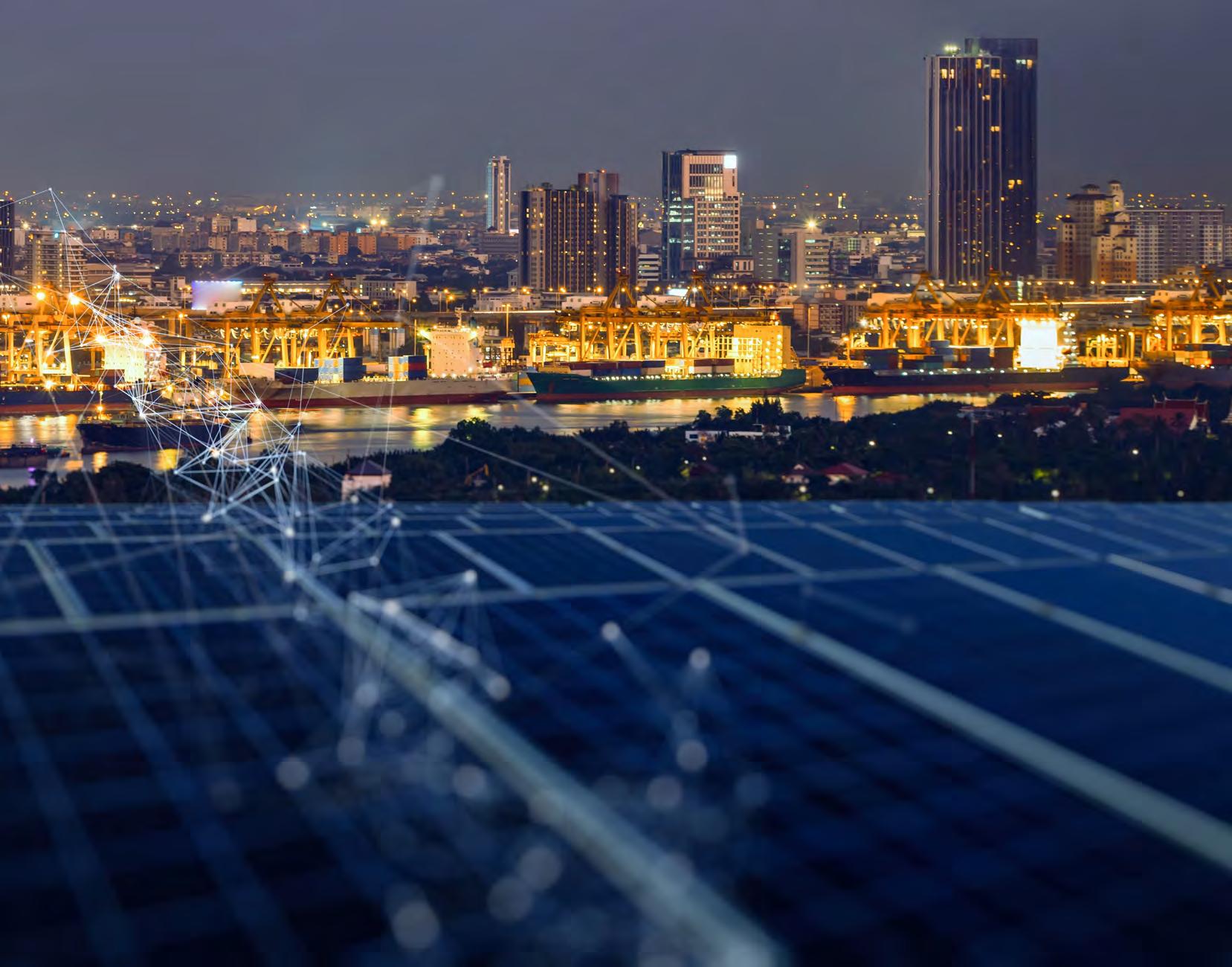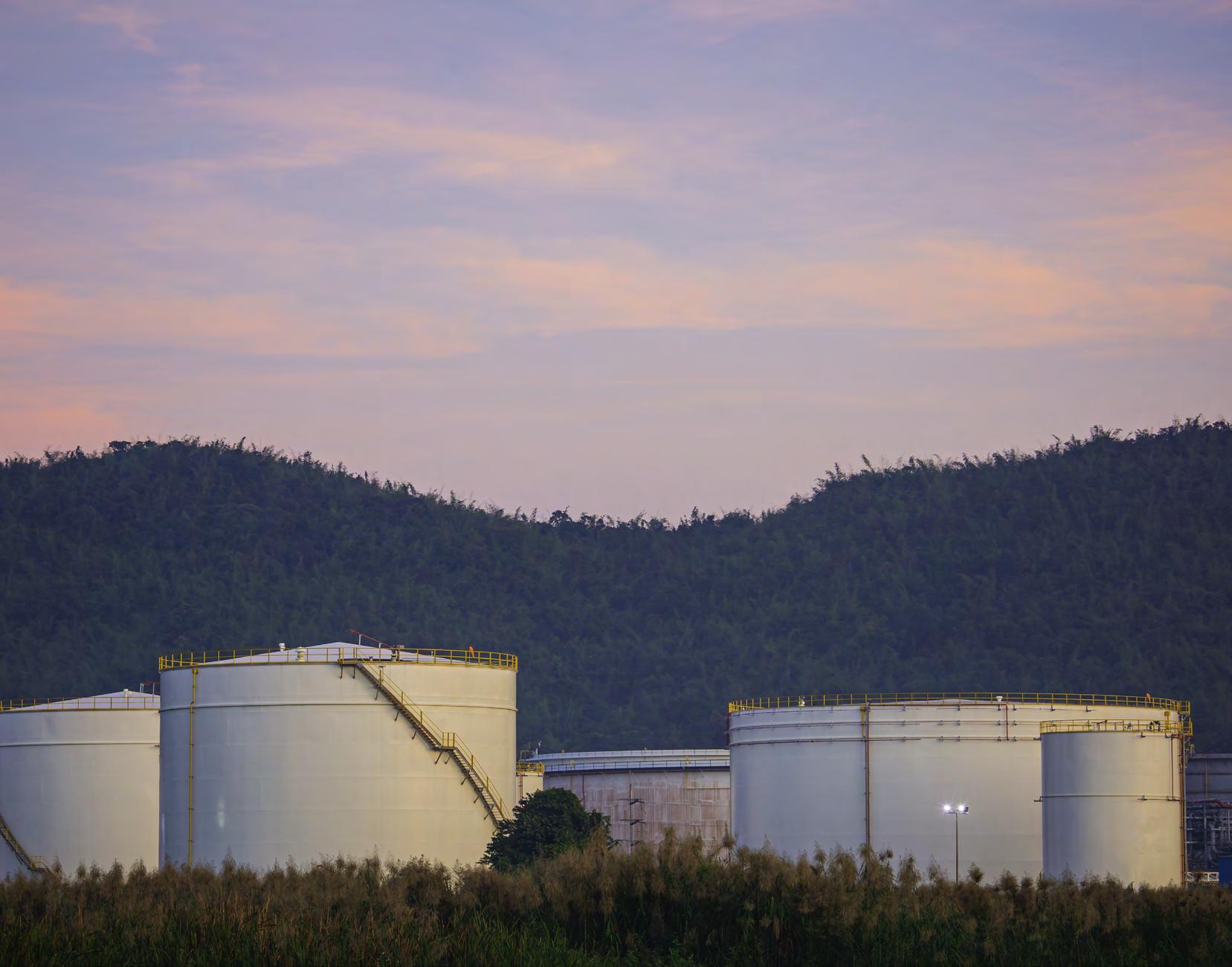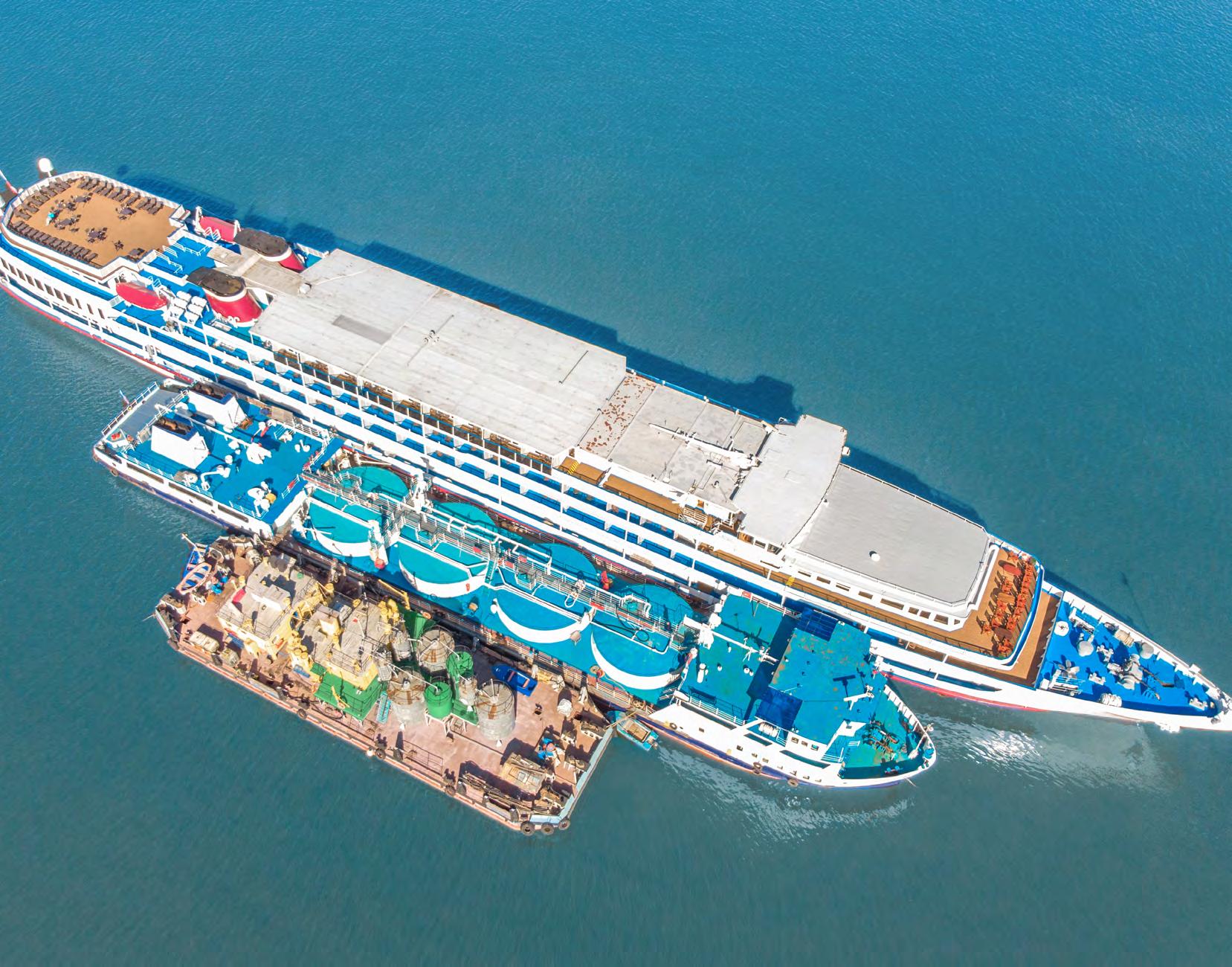
14 minute read
SCRUBBERS
from CSI Summer 2022
by Maritime-AMC
Use of scrubbing technology as a means of cleaning higher sulphur fuels continues, while new regulations and requirements have been coming into force
MAKING A
CLEAN SWEEP
Classification society DNV has put together a resume of changes being introduced for shipowners and manufacturers designing exhaust gas cleaning systems (EGCS).
DNV explains that the updated
MEPC.340(77) 2021 Guidelines for
Exhaust Gas Cleaning Systems, which were adopted in November 2021, mean shipowners and manufacturers operating or designing EGCSs will need to meet some modified requirements.
The new guideline applies to all EGCS installations that are delivered to vessels or are significantly modified on or after 1 June 2022.
For EGCS installations with a documented contractual delivery date prior to 1 June 2022, but where delivery was delayed due to the pandemic, for instance, the MEPC.259(68) guideline may still be applied, DNV explains.
DNV advises its customers to take an active role in the EGCS business and to finalise their preparation to meet the upcoming challenges clarified in the MEPC.340(77) guideline by: » Reviewing document templates for additionally required information to be included » Updating data processing and reporting tools to meet the new requirements » Revising specifications of the water monitoring units, reflecting the increased sampling frequency as well as the implementation of the new definition of phenanthrene equivalent » Critically reviewing the piping arrangements directing discharge from temporarily stored process water and evaluating the potential need for additional water monitoring systems. It has now been agreed that EGCSs following Scheme A approval need to perform daily SO2/CO2 emission checks as a vital parameter to monitor system compliance, DNV explains.
“The Onboard Monitoring Manual (OMM) should now also include the means by which ongoing compliance would temporarily be indicated in case of failure of a single
monitoring device (8.2.8). Also, guidance should be given on which indicators can be used to identify a malfunction of the EGCS (8.2.10).
“Under Scheme B, where operation of the EGCS is required to demonstrate the functionality of the monitoring system, a description of the operational condition(s) needed for their verification during the initial survey now needs to be included in the OMM (8.4). If properly done, this description may replace the need for the additional submission of a MARPOL survey test plan.
“The EGCS Technical Manual will need to be extended by a clear procedure on how to produce reports that indicate non-compliant conditions or temporarily ongoing compliance as per 8.2.8 (4.2.2.1.9, 5.6.1.7).”
Following the new guidelines, the data recording and reporting tool – in addition to required measurement values – now also needs to record and report the applicable limit values for all operational and emission-related parameters, the class society explain. “To be able to report applicable emission ratio limit values, the data processing tool needs to be able to identify whether the vessel is sailing within or outside Emission Control Areas. For parameter limits which are allowed to be exceeded by an aggregated period, the logging tool should be capable of automatically evaluating and sufficiently reporting failures in meeting these criteria.”
Discharge monitoring will also be required, the class society explains.
“Unlike as stated in the MEPC.259(68) guideline, separate fixed discharge limit values have been introduced for process water being discharged from any kind of temporary storage, such as holding or zerodischarge tanks. However, stated limit values (pH = 6.5, PAH = 50 µg/L, turbidity = 25 FNU) only apply for direct discharge to the sea. Water from holding tanks can still be discharged together with process water during open-loop operation, provided the respective discharge limits are met.
“The requirements for the sampling and reporting of nitrate analysis results have been eased a bit with the new revision. It is now acceptable to report nitrate concentrations gathered from similar installations instead of always performing individual water sampling and analysis. Nitrate discharge data can now also be presented as the difference of inlet and outlet concentrations.
“Finally, a special focus needs to be put on the changes made to the minimum recording frequency requirement for monitoring washwater discharged to sea. While MEPC.259(68) required a sampling and recording frequency of not less than 0.0035 Hz (every 4.76 min), it has now been increased to 0.011 Hz (every 90 sec). This may be a challenge for all monitoring units which are installed in a bypass pipe of the main discharge lines.”
WÄRTSILÄ AGREES ORDER
Technology group Wärtsilä has secured an agreement for its exhaust gas cleaning systems to be installed on two newbuild 218m roll-on/rolloff passenger vessels at Guangzhou Shipyard International (GSI) in China.
The contract, signed in February, will see Wärtsilä fit and commission two 25MW V-SOx hybrid scrubber systems, which can run in both open and closed loop configurations, on each vessel. The order is a result of Wärtsilä’s commitment to the AsiaPacific region, where the organisation has regional resources to enable it to provide sales, support and lifecycle services.
By choosing to install Wärtsilä’s exhaust gas abatement technology, the RoPax vessels will immediately comply with the 0.5% global sulphur cap and will also be future-proofed against impending regulatory change. This is because Wärtsilä’s modular, lifecycle technologies can be upgraded to tackle other pollutants, including nitrogen oxide (NOx), particulate matter (PM) and carbon dioxide (CO2).
Wang Bin, area sales manager at Wärtsilä Exhaust Treatment in China, says: “We are very excited to start 2022 with this order of SOx scrubbers onboard two RoPax vessels being built by our partners at GSI. This agreement not only proves our long-term partnership with GSI, but also demonstrates the commercial and technical viability of scrubbers in shipping’s complex decarbonisation landscape.”
“Our technology completely fulfils technical requirements for newbuilds, ensures compliance with current regulation and is also the first building block for future sustainability innovation. We look forward to working with GSI on this collaboration and others in our future together.”


Jiang Lei, purchasing manager at GSI, says: “It is a real pleasure for us to be working with Wärtsilä to fulfil this latest order on two RoPax vessels. We recognise the long-term potential of scrubbers for solving many crucial challenges in the shipping industry and we are proud to carry out installations at our development-oriented shipyard.”
Wärtsilä and GSI will complete the delivery and installation of the four scrubber systems by the end of 2023 for both vessels.
NO SCRUBS
Global marine insurer North has released analysis that summarises its understanding of the positions taken by ports that have or will prohibit the use of exhaust gas cleaning systems (EGCS), or have placed conditions on their use.
EGCS are an accepted equivalent measure in complying with the International Maritime Organisation 2020 global sulphur cap, but their use has split the shipping industry. Ports around the world are looking at the impact of scrubber use in their waters.
A number of ports and regions have already stated that they will not allow the discharge of washwater from scrubbers. For more details, visit: tinyurl.com/NorthAnalysis RULE DEADLINE
The 2021 EGCS Guidelines (MEPC.340(77)) were adopted at the International Maritime Organization (IMO) Marine Environment Protection Committee (MEPC) meeting in November last year. The new rules were set to enter into force six months later and apply to all newbuild and retrofit installations. Alpha Laval explains that they will also apply when an installation is changed to such a degree that the EGCS Technical Manual needs to be amended. So, except in the latter situation (major conversion), the 2021 EGCS Guidelines apply to new installations and do not impact existing installations.
Significant changes from the previous guidelines include: » When a zero-discharge area prevents the immediate discharge of cleaned bleed-off water, the tanks used to for temporary storage of the water must meet a strict PAH limit at the tank discharge point. The new limit is 50 µg/L, independent of discharge flow rate and engine load. » The discharge water monitoring and logging frequency have increased from 0.035 Hz to 0.0111 Hz, which is around every 90 seconds. » There are several changes that impact the logging system and scrubber documentation, but not
EGCS function as we know it today. Mandatory daily spot-checks are now required for Scheme A scrubbers.
The Committee approved an MEPC circular, MEPC.1/Circ.883/ Rev.1, which applies to all EGCS, old or new. It provides updated guidance for indicating compliance if a single monitoring instrument fails, as well as recommended actions to take if the EGCS fails to meet the provisions of the EGCS Guidelines.
Fortunately for owners and operators, the majority of IMO member states did not approve the suggestion that ships with a scrubber installed should carry compliant fuel for a full voyage. This had been suggested as a redundancy measure to cover any EGCS malfunction and it would have removed the possibility for “indication of ongoing compliance” in the event of a single monitoring instrument failure.
The scope of work for harmonising discharge water regulations was accepted during MEPC 77. This included work to be done to: » Agree on a text to change MARPOL » Finalise a guideline for conducting risk assessments » Finalise a guideline for conducting impact assessments » Develop a guideline for scrubber sludge disposal ashore
» Establish a database of substances identified in the discharge water. Once the guidelines above are established, a government can apply for its waters to become a “scrubber sensitive area”. (It remains unclear whether this includes only territorial waters or extends to the EEZ boundary of 200 nautical miles.) An assessment of risk and impact will then be conducted, and following approval the government can ban scrubber discharge in the body of water defined.
To clarify, this is a harmonisation of the regulatory structure, which will result in all member states having the same definitions and guidelines for conducting impact and risk assessments. In other words, they will be aligned on what is considered harmful.
Shipowners will still face a patchwork of regulations, however, in the sense that not all ports or coastal areas will have the same regulations. PPR AGREEMENTS
The ninth session of the International Maritime Organization’s SubCommittee on Pollution Prevention and Response (PPR 9) was held remotely in April, with a wide range of topics on the agenda, including biofouling, ballast water management, black carbon, sewage treatment and marine plastic litter.
PPR agreed on draft guidelines on risk and impact assessments of the discharge water from exhaust gas cleaning systems when considering local or regional regulations. Topics discussed at the meeting included: » Draft guidelines supporting the implementation of control of cybutryne in the Anti-Fouling
System Convention » Draft guidelines on risk and impact assessments of the discharge water from exhaust gas cleaning systems (EGCSs) when considering local or regional regulations » Draft amendments to MARPOL
Annex V making the garbage record book mandatory also for ships between 100 and 400 GT » Unified interpretations on biofuels,
Selective Catalytic Reduction (SCR) systems and issuing certificates for ships using other approaches to ballast water management.



A NEW LOOK FOR OUR SURFACE UTM RANGE!
CYGNUS 4+ GENERAL PURPOSE ULTRASONIC THICKNESS GAUGE
• Multiple-Echo mode for accurate, through-coat measurements, specified by Classification Societies • Ideal for heavily corroded metals with thin/no coating • Front sunlight readable LCD display with Live A-scan
SCAN QR CODE FOR A FREE QUOTE OR CALL US ON +44 (0) 1305 265 533
WWW.CYGNUS-INSTRUMENTS.COM
QUOTE CSI2022 WITH ORDER
SEE THE CYGNUS 4+ IN ACTION ON STAND B57!
PURETEQ: STATE-OF-THEART SCRUBBER MAKER
PureteQ designs, delivers and commissions built-to-fit maritime scrubber systems for shipowners who want to save money on fuel by continuing use of heavy fuel oil (HFO). The price span between compliant fuel and HFO have increased to almost historic levels and interest for new scrubber systems is increasing with the larger price span.
All PureteQ scrubbers come with state-of-the-art intuitive control systems, including full real time remote accessibility. This feature allows for detailed troubleshooting assistance to crews without physical attendance.
The technology allows us to regulate waterflow to the scrubber from 10% to 100% of the design capacity, as opposed to other brands that will only allow for minor regulating of waterflow. The result is superior energy performance and saving of fuel. SERVICE AGREEMENTS FOR ANY BRAND OF SCRUBBER SYSTEM
At present, PureteQ service most brands of scrubbers, including our own PureteQ Scrubber System. We do this in all parts of the world pending local covid and/or travel restrictions.
PureteQ has offices in Europe and Asia and from there, our trained marine engineers are dispatched from the nearest location to provide service. Often, we are already working on ships in various ports around the world, for example the US and South America, hence some travel costs may be saved.
We are certified in most sensors and can calibrate and issue certificates for compliance sensors, including CEMS systems when attending the vessels once per year. Depending on instrument air quality for CEMS systems, the cell will have to be refurbished at intervals. PureteQ offers practical solutions to prolong the life of the cell and increase service intervals.
PureteQ offers service agreements without bindings and without prepayment – you only pay for the services that you need, at a fair price. As an integral part of this agreement, we offer a 24/7 service desk manned by professional marine engineers, who have undergone comprehensive training in all components of a scrubber systems, including sensors. In other words, we offer you an unparalleled one-stop-shop for scrubbers and associated equipment.
We conduct numerous training sessions for onshore personnel, as well as for crews and officers. We have established a modular training programme to fit the individual shipowners need. This remains very popular among crews, officers and
PURETEQ Service agreements without prepayment for any brand of exhaust gas cleaning system

From the left His Royal Highness the Crown Prince Frederik of Denmark, CEO of ESTECH Søren G. Larsen, Climate Minister Dan Jørgensen and Mayor of Odense Peter Rahbaek Juel visiting the Combined Carbon Capture and Power to X plant developed by ESTECH a company in PureteQ Group
onshore personnel. The training is done virtually or, if required, with an on-board presence as part of the annual service visit.
All training modules offer sharepoint-based questionnaires and tutorials to aid understanding of the training and when the exams have been passed, training certificates are automatically issued by PureteQ.
You will be in safe hands when you enter into a PureteQ/PureServ service agreement. We have the tools, the manpower and the skillset to make a difference. Furthermore, we supply some of the most advanced and easyto-use software in the business. We can even replace software (including some hardware) on other brands of scrubbers if needed.
We are also offering clients cloudbased software for environmental performance reporting and optimisation of scrubbers across the fleet. It features the measuring of MARPOL compliance, operational performance (impact on SFOC) as well as environmental performance reporting, such as CO2, sulphur and later particulate matter reductions. The software is a perfect match to new International Maritime Organization regulations on EED(X)I & CCI, when well-to-wake principles apply. This software will allow for cross-ship/ fleet learning for crews, hence reducing costs.
The service agreement is an umbrella agreement that has several options tailored to match individual needs. Shipowners may at any time add or exclude the options and include or exclude ships from the agreement – all it takes is an e-mail describing the changes, which will then be confirmed and carried out. Service agreements can be drawn up for any brand of scrubber system.
In 2018, ESTECH – part of the PureteQ Group – began a research programme into carbon capture technology, and we are pleased to announce that we have recently been granted patents in the US as well as Europe on a technology that combines carbon capture from exhaust gas with power-to-x. The solution is a unique combination of carbon capture and parallel production of hydrogen.
Tests carried out at our pilot plant at a Danish wastewater treatment plant indicates that approximately 80 % of the green energy utilised for carbon capture is stored in hydrogen. The CO2 as well as the hydrogen are building blocks for fuels and other products. The technology has the potential to become the most energy-efficient CCS technology on the market for small and medium-sized industries, and even for some of the bigger companies.
The technology is based on the PureteQ’s exhaust gas purification technology with patented hydrodynamic fluid distribution, as well as on the existing and well-proven digital platform for other in-house technologies. The hydrodynamic fluid distribution ensures optimal conditions for the gas/fluid reaction, resulting in a smaller reaction chamber/scrubber.
The group has been able to accelerate the product development process and we have begun the task of scaling the technology by more than 100 times existing capacity. When this work is well underway, we intend to build the first commercial plant.
The first full-sized commercial CCCH2 plant is expected in 2023/2024. And it doesn’t stop there – in 2023, we intend to investigate the feasibility of on-board CCS based on standard amine processes.

For more information, contact: Anders Skibdal, CEO Tel: + 45 4017 1400 Email: anders@pureteq.com
Michael Mouritzen, Sales Tel: +45 4014 4481 mim@pureteq.com pureteq.com










